2016 Kawasaki KX250F Review
Kawasaki holds fast in 2016 with a well-refined yet unimproved KX250F
With Kawasaki’s KX450F undergoing a complete redesign for 2016, apparently it wasn’t the KX250F’s turn to receive any love, as it is the only Japanese 250cc motocrosser not to receive any noteworthy upgrades for next racing season.
2016 Kawasaki KX250F
| Engine | 18.5/20 |
| Suspension/Handling | 14/15 |
| Transmission/Clutch | 9.0/10 |
| Brakes | 9.0/10 |
| Instruments/Controls | 5.0/5 |
| Ergonomics/Comfort | 9.0/10 |
| Appearance/Quality | 9.0/10 |
| Desirability | 8.5/10 |
| Value | 8.5/10 |
| Overall Score | 90.5/100 |
In fact, we might as well get the changes that Kawasaki made this year out of the way right now, because it’s a pretty short list. The only engineering upgrade was the move to a stronger, more durable bolt at one location inside the engine cases, Other than that, the KX250F receives a slightly different shade of green on the various anodized plugs and other parts that dress up its engine, a rear fender that is now green instead of white and a remarkably subtle change to the graphics on the radiator shrouds. That’s it.
But despite its lack of improvements, the 2016 KX250F is still a competitive machine. In fact, we expect to see a lot of them getting hammered around motocross tracks all over the U.S., not only because of Kawasaki’s tremendous dedication to amateur rider support through its Team Green program, but also because there is still a lot to like in the quarter-liter Kwacker.
The heart of this little green beast is still the product of a considerable championship pedigree. The liquid-cooled, 249cc, DOHC, four-valve engine uses a proven 77.0 × 53.6mm bore and stroke, with a version of the reinforced “bridged box” piston that Kawasaki pioneered in motocross. Derived from Formula One racecar technology, the bridged box piston features extremely short skirts, instead relying on reinforced external ribs on the underside of the piston to maintain rigidity. This design was last revised in 2015, at which time Kawasaki added a few grams of weight to the piston but mitigated that additional weight by incorporating a lighter piston pin to keep the KX250F’s top-end weight virtually the same without sacrificing any durability.
When we tested the 2014 KX250F, we raved about its strong mid-range punch and willingness to keep pulling in the upper rpm range, but Kawasaki altered the power delivery in 2015 by fitting a heavier ignition rotor, (9.5kg-cm² compared to the 2014’s 9.0 kg-cm²) to bring the power in a little lower in the rev range for improved traction when exiting corners. Like the rest of the engine – except for the aforementioned bolt – that remains unchanged for 2016.
Fuel delivery is still handled by another Kawasaki-first for the 250cc class, a Keihin Digitial Fuel Injection system (DFI) that uses a dual injector in its 43mm throttle body. The second injector delivers an extra squirt of fuel under acceleration to maximize the 250F’s power, particularly at higher rpm. The second injector is located higher up in the air duct. In 2015, Kawasaki made a slight revision to the system by reducing the downstream injector droplet size to 75 microns; the upstream injector sprays particles with a droplet size of 120 microns. The finer size and wider spray pattern of the downstream injector was intended to fortify the KX250F’s low- to mid-range power and improve throttle response. Revised ECU settings matched the injector and magneto rotor changes.
Even though it was effectively to introduce us to a bike we already knew, Kawasaki staged a press event at Milestone MX Park in Riverside, an essentially flat racetrack with fair-sized jumps that include long tabletops, step-ups, double and triples, most of them with steep faces. Milestone’s mostly clay surface can also form hard-faced ruts in the corners. These conditions reward machines with a lot of mid-range power, and fortunately the Kawasaki still delivers that in spades.
Our test rider was an enthusiastic 21-year-old Nic Garvin, a professional level off-road and motocross racer who currently contests the SRT/AMA National Championship Hare & Hound Series. Garvin, who normally rides European bikes in the Hare & Hound Series, required very little time to get comfortable aboard the Kawasaki, pronouncing it to be quick and responsive off the bottom. As we expected, he praised the Kawasaki’s potent mid-range thrust, which is the engine’s strong point. At the same time, Garvin noted that the KX’s top-end flattened out earlier than expected, requiring an extra upshift of its five-speed transmission in order to clear some of the jumps with longer approaches. The KX can rev fairly high, but it noticeably loses its snap as its rpm heads toward the ozone. Garvin’s take is that fast lap times will require more shifting than some of the other machines in its class.
“When you come out of a corner, it feels really nice, but you do have to shift it to get the power out of it,” Garvin said. “It has excellent mid-range power – that’s where all the power is in this motor. Switching to the more aggressive power coupler didn’t give it anymore top-end, but it gave it a little more low-end grunt, so you have a little more to work with. But you have to shift it early, and I noticed that the higher the rpm got, the harder it was to shift without using the clutch.”
Garvin also commented on the KX250F’s Launch Control, which can be activated by pushing a button on the left handlebar while stopped, in neutral, first or second gear. The Launch Control retards ignition timing in first and second gears to limit wheelspin off the starting line. Shifting into third gear automatically deactivates the Launch Control and returns to the engine’s normal ignition map.
“The Launch Control seemed to work especially well when I started in the dirt,” Garvin said, “I think it is cool, but it didn’t really help me as much when I tried to launch from the concrete starting pad, and I don’t think I would use it then.”
Good suspension and handling are also part of the speed equation, too, and while the KX250F sticks with Yamaha in shunning air fork technology – at least for now – its 48mm Showa Separate Function Fork (SFF) fork is well sorted and offers 12.4 inches of high-quality travel on the track. The SFF is another item that Kawasaki introduced to the class way back in 2011, and it works as well today as ever, soaking up big jumps and remaining supple through stutter bumps. The right fork leg houses a steel coil spring that incorporates a preload adjuster to simplify preload and ride height adjustment with the simple turn of a wrench rather than requiring fork disassembly to accomplish the same task. The left tube houses the damping system that controls ride quality. The SFF fork features 30mm main- and 35mm sub-pistons that move more oil volume at a lower internal pressure to keep the fork action smooth. Kawasaki engineers also paid attention to friction reduction in the fork by using a super-hard titanium coating on the inner fork tubes to prevent stiction through the stroke.
As delivered, our KX test unit’s fork was a little harsh on compression and wanted to rebound too quickly, but all it took was a minor tweak of the compression and rebound adjusters to dial it to a comfortable level for both our pro and vet testers alike. We simply went two clicks out on compression and four clicks in on the rebound to get the fork to settle into a comfortable zone for the jumps and bumps we encountered at Milestone.
The KX’s fully adjustable Showa piggyback reservoir shock is a perfect match for the fork, helping to keep the suspension action perfectly balanced through the rough stuff. The state-of-the-art shock features high- and low-speed compression damping adjustability as well as rebound and preload adjustability. Kawasaki engineers also worked to reduce shock friction by incorporating a self-lubricating Alumite coating on the inner surface of the shock cylinder wall. We certainly had no complaints about the rear suspension quality. The shock action was plush yet controlled, and that helped the Uni-Trak linkage rear suspension system to transfer the KX’s power to the ground at Milestone.
The KX250F’s aluminum perimeter chassis features the same slimmed-down subframe that was introduced on the 2015 KX450F, and the entire chassis design was completed with strict attention to mass centralization and to allow easier rider movement in the cockpit. The 250F rides on a 58.1-inch wheelbase, and its steering performance comes courtesy of a 28.7-degree rake and 5.0 inches of trail. The KX’s claimed weight, with its smallish 1.61-gallon fuel tank topped off, is 233.6 lbs.
While the KX250F doesn’t feel unduly heavy, we did notice that it isn’t as willing to carve with precision like some of its competitors. The KX’s steering is more deliberate, and the front end tends to want to skate, forcing the rider to concentrate a little more in order get it to follow a tight line in a sweeper or track through rutted corners. In sweepers or semi-banked turns, steering the Kawi with the throttle helps to get it pointed in the right direction.
“It seems like in order to get the Kawasaki to follow a rut you really have to be aggressive and attack it hard,” Garvin said. “I fought it to stay in the ruts, and even then I found it wanting to push to the outside of the turns. The flip side to that is that it is extremely stable at high speeds. It doesn’t wiggle at all. I think it would be a pretty good bike for desert racing or endurocross because it is so stable.”
Ergonomic comfort is another plus for the KX250F. It feels slim and roomy, and its radiator shrouds are tucked in nicely, which makes flicking it around an easy task. We made a simple bar adjustment to get it more to our liking, but the KX rider can make a variety of adjustments, thanks to an upper triple clamp that features two sets of handlebar mount slots to give a choice of four handlebar positions—25mm forward, 15mm forward, standard or 10mm rearward. The KX’s footpeg brackets are also adjustable to two different positions. There aren’t too many riders, big or small, who won’t be able to get comfortable on the Kawasaki.
Stopping this little green speedster was also no trouble at all. The KX250F’s 270mm front brake rotor, designed in conjunction with aftermarket brake manufacturer Braking is ably clamped by a Nissin two-piston front caliper. Out back, stopping duties are attended to by a 240mm wave rotor and a single-piston caliper. Garvin, who is use to Brembo brakes on his racebike, offered high praise for the Kawasaki’s binders.
“Brakes always stand out to me because I don’t ride Japanese motorcycles when I race,” Garvin said. “I’m used to the brakes on my bikes stopping on a dime, and by comparison the Japanese brakes typically feel weak to me. But I was really impressed with the KX. Its brakes never feel mushy, and the power is always there.”
So, there you have it. The 2016 Kawasaki KX250F performs exactly like the 2015 model because it is almost exactly like the 2015 model in every way, including its $7599 MSRP. For that price, you will get a 250cc motocross machine with bruising mid-range power, excellent suspension and a chassis that trades a little steering precision for tremendous straight-line stability. The KX is a very good bike, but with the strides that others have made in 2016, it will be interesting to see how the KX250F stacks up once the dust settles.
| 2016 Kawasaki KX250F Specifications | |
|---|---|
| Engine | 4-stroke, 1-cylinder, DOHC, water-cooled |
| Displacement | 249cc |
| Bore x Stroke | 77.0 x 53.6mm |
| Compression Ratio | 13.8:1 |
| Fuel System | DFI with 43mm Keihin throttle body and dual injectors |
| Ignition | Digital DC-CDI |
| Transmission | 5-speed |
| Final Drive | Chain |
| Front Suspension | 48mm inverted Showa SFF telescopic fork with 40-way spring preload adjustability and 22-position compression and 20-position rebound damping adjustability, 12.4 inches of travel |
| Rear Suspension | Uni-Trak linkage system and Showa shock with 19-position low-speed and 4-turns high-speed compression damping, 22-position rebound damping, fully adjustable spring preload, 12.2 inches of travel |
| Front Tire | 80/100-21 |
| Rear Tire | 100/90-19 |
| Front Brake | Single semi-floating 270mm Braking petal disc with dual-piston caliper |
| Rear Brake | Single 240mm Braking petal disc with single-piston caliper |
| Frame | Aluminum perimeter with aluminum subframe |
| Wheelbase | 58.1 inches |
| Rake/Trail | 28.7°/5.0 inches |
| Overall Length | 85.4 inches |
| Overall Width | 32.3 inches |
| Overall Height | 50.0 inches |
| Ground Clearance | 13.0 inches |
| Seat Height | 37.2 inches |
| Claimed Curb Weight | 233.6 lbs. |
| Fuel Capacity | 1.61 gallons |
| Color | Lime Green |
More by Scott Rousseau



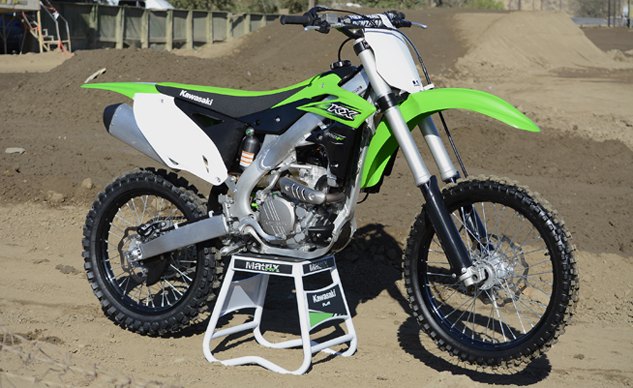
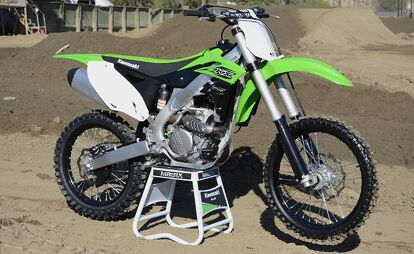



















































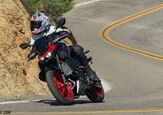
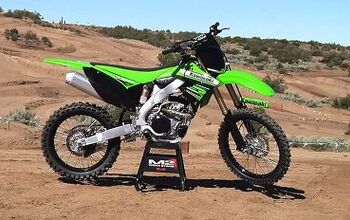

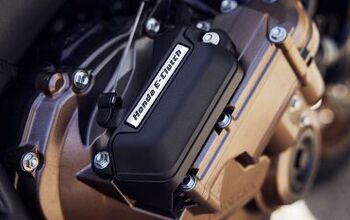


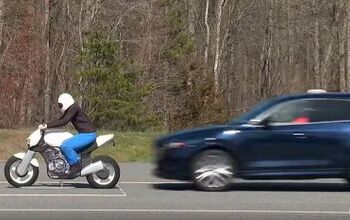
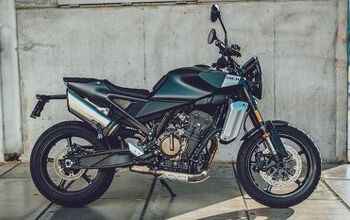


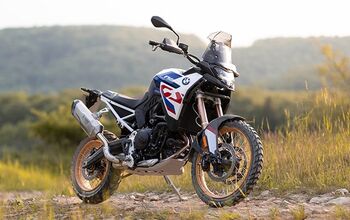
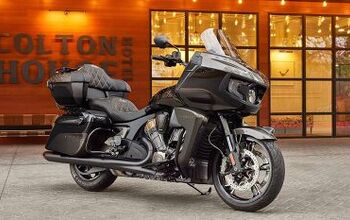



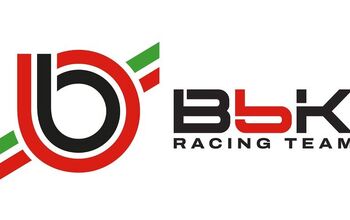
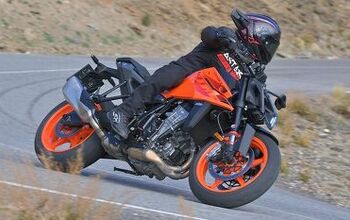

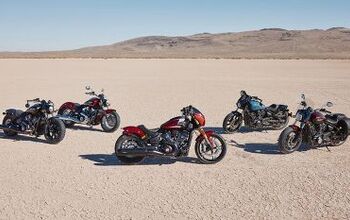
Comments
Join the conversation
all these articles on the kx250f keep saying the "powerband". I hope they mean the full range of power and not an actual powerband. because sorry to break it to you but im pretty sure only two strokes have those.